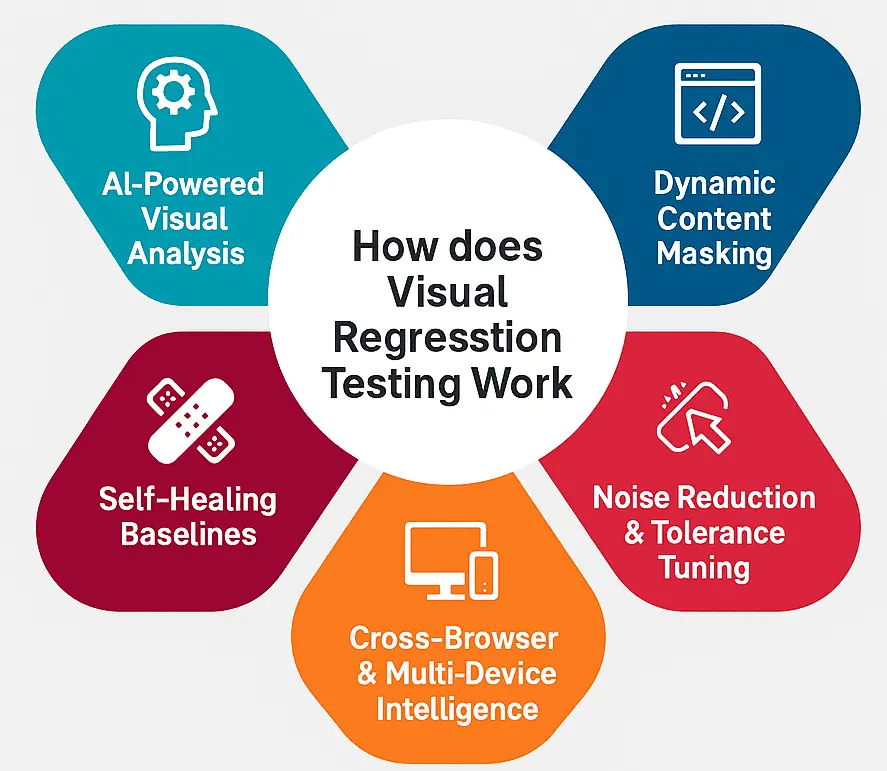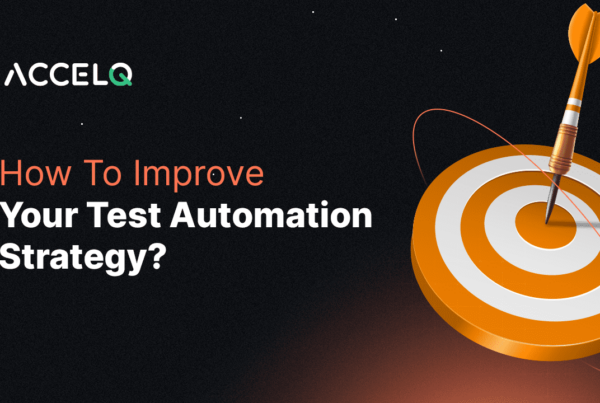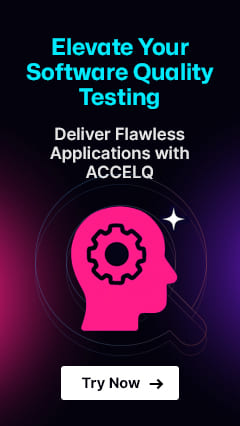Smart Visual Testing: How to Catch What the Eyes Miss?

As applications scale across multiple devices, languages, and themes, traditional pixel-to-pixel checks break down. Visual testing steps in here, leveraging AI and automation to detect issues that manual reviews or pixel-based methods might overlook. This next-generation solution ensures visual elements are accurately represented and function seamlessly, meeting the increasing complexity of modern software.
In this blog, we’ll explore how AI-powered smart visual testing addresses the gaps left by traditional testing methods, helping QA professionals deliver more reliable applications, faster and with higher quality.
The Limits of Traditional Visual Testing
Traditional visual regression testing methods like pixel-to-pixel comparisons or static baseline checks are essential QA automation tools. But they often throw out lots more noise than signal, flagging minor differences such as a few pixels or static content edition, without any real impact for user experience at all.
The difficulty faced here is that these methods cannot discriminate between irrelevant shifts and key issues that will influence users. On a trivial note, any shift in padding could be flagged, even though this really does not affect use.
On the other hand, faults like broken CTAs, misaligned buttons, and accessibility violations often go unnoticed! Context-Aware smart visual testing streamlines your visual regression process by focusing on the most significant differences. This precision reduces noise, improving the efficiency of your automated testing and delivering faster, more reliable results.
What is AI-Powered Visual Testing?
At its heart, Context-Aware visual testing is much more than comparing images: It’s AI-driven contextual awareness. Neither does it detect every visual difference; it only looks for meaningful changes, such as a concealed button or a broken link, while ignoring minor details like a 2px padding shift.
By employing advanced algorithms, the Service evaluates visually how much changes made to formatting will affect user interface and experience. It is guaranteed that only pertinent issues are thereby discovered, a step which significantly cuts down on the work done manually by hand.
How Advanced Visual Testing Works?
Baselines, Comparisons, and AI
Automated visual regression testing begins with establishing baselines, the “correct” state of a UI element. These baselines are then compared to current UI states. However, traditional methods rely only on pixel-to-pixel comparisons. Visual testing improves this by using AI-driven context to assess which differences matter and are likely to impact users.
By utilizing artificial intelligence, we’ve developed a method to recognize features such as a button’s redesign and its implications for the user, even in cases of misalignment or loss of functionality. Thus, only those bugs that matter are logged, reducing noise and concentrating on real user-impacting problems.
For more on how AI enhances the testing process, see our page on AI in Testing.
Examples of Smart Visual Testing and Techniques:
The strength of visual regression testing techniques in AI lies in the combination of techniques like screenshot comparisons and intent-based testing. By these means, our system can tell which are superficial changes that will not affect user experience and which actually do.
Here are some key visual regression testing techniques used:
- Screenshot Comparison: Compares the current screen to baseline images for any visual differences.
- Example: If the button size changes in a design update, the system will detect and flag this as a meaningful difference, ensuring consistency.
- Intent-based Testing: Goes beyond pixel-level changes to ensure visual elements behave according to business logic and user expectations.
- Example: If a user profile icon changes color or position in the UI, intent-based testing verifies that it aligns with expected functionality and user flow.
- Dynamic Content Masking: Filters out constantly changing elements, such as timestamps or user data, from the visual comparisons.
- Example: A dashboard that displays different timestamps based on user session times will not be flagged for visual differences since dynamic content is masked.
For more on visual regression testing in AI techniques, read our detailed guide on Automated Visual Regression Testing.
How does Visual Regression Testing Work?

AI-Powered Visual Analysis
One of smart visual testing’s most notable features is its AI-powered visual analysis. The system learns patterns from previous visual changes and is able to pick up on things that may otherwise be missed. For example, it can understand if a button has changed size. However, AI will also judge how this change affects the overall user experience – for instance, misalignments in mobile versus desktop views.
Dynamic Content Masking
Dynamic content, such as user-specific data, timestamps, or frequently changing elements, often leads to false positives in visual regression testing. Visual regression testing addresses this by applying dynamic content masking, allowing it to focus on essential parts of the UI while ignoring irrelevant dynamic elements that frequently change.
Noise Reduction & Tolerance Tuning
Traditional visual regression tests often produce excessive false positives, especially when dealing with minor layout shifts. Noise reduction and tolerance tuning ensure that only real defects are flagged by adjusting the sensitivity of various elements. This process saves valuable testing time and helps reduce the noise generated in test logs.
Self-Healing Baselines
One of the breakthrough features in visual testing is self-healing baselines. The system can automatically adjust baselines when there are intentional UI changes, such as a design update or a new app version. This automation reduces the need for manual intervention in updating baselines for every minor UI change, ensuring that the testing environment stays up-to-date.
Cross-Browser & Multi-Device Intelligence
With applications running on a variety of browsers and devices, automated visual regression testing includes cross-browser and multi-device intelligence to detect platform-specific issues. This feature ensures consistency and reliability across different environments, catching layout problems that might arise on specific devices or browsers.
Visual Regression Testing in CI/CD
CI/CD (Continuous Integration/Continuous Deployment) pipelines are standard practice in today’s fast-paced world of development. Smart visual testing fits right into these pipelines, providing teams with visual tests that do not slow down the release cycle.
AI-driven visual checks are added to the CI/CD pipeline, allowing teams to identify visual defects quickly and without delaying a point release. For instance, nightly test runs might flag variations in branding, such as logo misalignments, or differing colors for different elements of design, even if this not obvious on screen to each developer reading through the code making up that site, but there must be a difference between every version and so forth ensuring all builds maintain visually consistent webspace aesthetics.
For more detailed information on Continuous Testing, please visit our Continuous Testing in DevOps guide.
Challenges & Guardrails
While visual testing has many advantages, there are also challenges that teams will face. Over-reliance on AI sometimes leads to false negatives when the system fails to pick up more complex or subtle points. As new features are developed rapidly during this phase testers manually verify vital changes, just in case anything has been overlooked.
In addition, discipline in maintenance is vital to maintaining a proper self-healing baseline. Testers must ensure, with automatic adjustments, that changes are intentional and the system is adapting properly to those, without another technology being inserted into the regular flow unnoticed–all of which would render things even more complicated than they need be for nothing that so frequently raises itself up through other means.
Future Outlook: Smart Testing with ACCELQ AI
The future for smart visual testing is bright. ACCELQ’s AI-powered autopilot leads this transformation. With the benefit of AI, it has a finer capability to detect anomalies and align testing to business processes. So it takes visual regression testing up a level.
ACCELQ’s platform integrates visual testing into an end-to-end automation workflow, enabling consistency in web, mobile and API testing. As AI continues to develop, visual testing will become even more accurate, efficient, and context-aware.
To explore AI-powered automation solutions, visit ACCELQ Autopilot.
Conclusion
We now turn to examine one of the most significant changes in UI validation in recent years. By combining AI with automation, Smart Visual testing helps teams to detect issues that manual testing or traditional pixel-based comparison cannot discern. Combining fewer false positives, greater accuracy and seamless integration into the CI/CD pipeline, Visual testing allows teams to ship better applications quicker!
Enhance your testing workflows with ACCELQ’s AI-powered automation. Start your free trial today.
Yuvarani Elankumaran
Technical Consultant at ACCELQ
Yuvarani Elankumaran is a highly skilled technical consultant at ACCELQ. With over a decade of experience in the field of Test Automation, Yuvarani is a seasoned professional who is well-versed in a variety of programming languages and automation frameworks.
You Might Also Like:
 ACCELQ Product Overview
ACCELQ Product Overview
ACCELQ Product Overview
 Why Financial Enterprises Choose ACCELQ for Test Automation
Why Financial Enterprises Choose ACCELQ for Test Automation
Why Financial Enterprises Choose ACCELQ for Test Automation
 How To Improve Your Test Automation Strategy?
How To Improve Your Test Automation Strategy?

































